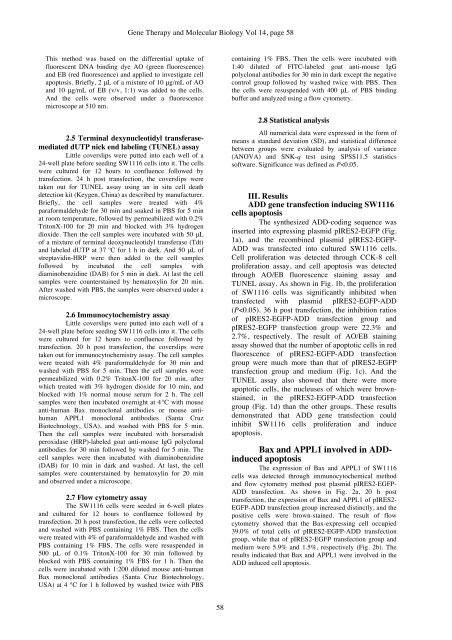Bax and APPL1 are involved in DCC-ADD induced colorectal ...
Bax and APPL1 are involved in DCC-ADD induced colorectal ...
Bax and APPL1 are involved in DCC-ADD induced colorectal ...
Create successful ePaper yourself
Turn your PDF publications into a flip-book with our unique Google optimized e-Paper software.
This method was based on the differential uptake of<br />
fluorescent DNA b<strong>in</strong>d<strong>in</strong>g dye AO (green fluorescence)<br />
<strong>and</strong> EB (red fluorescence) <strong>and</strong> applied to <strong>in</strong>vestigate cell<br />
apoptosis. Briefly, 2 μL of a mixture of 10 μg/mL of AO<br />
<strong>and</strong> 10 μg/mL of EB (v/v, 1:1) was added to the cells.<br />
And the cells were observed under a fluorescence<br />
microscope at 510 nm.<br />
2.5 Term<strong>in</strong>al dexynucleotidyl transferasemediated<br />
dUTP nick end label<strong>in</strong>g (TUNEL) assay<br />
Little coverslips were putted <strong>in</strong>to each well of a<br />
24-well plate before seed<strong>in</strong>g SW1116 cells <strong>in</strong>to it. The cells<br />
were cultured for 12 hours to confluence followed by<br />
transfection. 24 h post transfection, the coverslips were<br />
taken out for TUNEL assay us<strong>in</strong>g an <strong>in</strong> situ cell death<br />
detection kit (Keygen, Ch<strong>in</strong>a) as described by manufacturer.<br />
Briefly, the cell samples were treated with 4%<br />
paraformaldehyde for 30 m<strong>in</strong> <strong>and</strong> soaked <strong>in</strong> PBS for 5 m<strong>in</strong><br />
at room temperature, followed by permeabilized with 0.2%<br />
TritonX-100 for 20 m<strong>in</strong> <strong>and</strong> blocked with 3% hydrogen<br />
dioxide. Then the cell samples were <strong>in</strong>cubated with 50 μL<br />
of a mixture of term<strong>in</strong>al deoxynucleotidyl transferase (Tdt)<br />
<strong>and</strong> labeled dUTP at 37 o C for 1 h <strong>in</strong> dark. And 50 μL of<br />
streptavid<strong>in</strong>-HRP were then added to the cell samples<br />
followed by <strong>in</strong>cubated the cell samples with<br />
diam<strong>in</strong>obenzid<strong>in</strong>e (DAB) for 5 m<strong>in</strong> <strong>in</strong> dark. At last the cell<br />
samples were countersta<strong>in</strong>ed by hematoxyl<strong>in</strong> for 20 m<strong>in</strong>.<br />
After washed with PBS, the samples were observed under a<br />
microscope.<br />
2.6 Immunocytochemistry assay<br />
Little coverslips were putted <strong>in</strong>to each well of a<br />
24-well plate before seed<strong>in</strong>g SW1116 cells <strong>in</strong>to it. The cells<br />
were cultured for 12 hours to confluence followed by<br />
transfection. 20 h post transfection, the coverslips were<br />
taken out for immunocytochemistry assay. The cell samples<br />
were treated with 4% paraformaldehyde for 30 m<strong>in</strong> <strong>and</strong><br />
washed with PBS for 5 m<strong>in</strong>. Then the cell samples were<br />
permeabilized with 0.2% TritonX-100 for 20 m<strong>in</strong>, after<br />
which treated with 3% hydrogen dioxide for 10 m<strong>in</strong>, <strong>and</strong><br />
blocked with 1% normal mouse serum for 2 h. The cell<br />
samples were then <strong>in</strong>cubated overnight at 4 o C with mouse<br />
anti-human <strong>Bax</strong> monoclonal antibodies or mouse antihuman<br />
<strong>APPL1</strong> monoclonal antibodies (Santa Cruz<br />
Biotechnology, USA), <strong>and</strong> washed with PBS for 5 m<strong>in</strong>.<br />
Then the cell samples were <strong>in</strong>cubated with horseradish<br />
peroxidase (HRP)-labeled goat anti-mouse IgG polyclonal<br />
antibodies for 30 m<strong>in</strong> followed by washed for 5 m<strong>in</strong>. The<br />
cell samples were then <strong>in</strong>cubated with diam<strong>in</strong>obenzid<strong>in</strong>e<br />
(DAB) for 10 m<strong>in</strong> <strong>in</strong> dark <strong>and</strong> washed. At last, the cell<br />
samples were countersta<strong>in</strong>ed by hematoxyl<strong>in</strong> for 20 m<strong>in</strong><br />
<strong>and</strong> observed under a microscope.<br />
2.7 Flow cytometry assay<br />
The SW1116 cells were seeded <strong>in</strong> 6-well plates<br />
<strong>and</strong> cultured for 12 hours to confluence followed by<br />
transfection. 20 h post transfection, the cells were collected<br />
<strong>and</strong> washed with PBS conta<strong>in</strong><strong>in</strong>g 1% FBS. Then the cells<br />
were treated with 4% of paraformaldehyde <strong>and</strong> washed with<br />
PBS conta<strong>in</strong><strong>in</strong>g 1% FBS. The cells were resuspended <strong>in</strong><br />
500 μL of 0.1% TritonX-100 for 30 m<strong>in</strong> followed by<br />
blocked with PBS conta<strong>in</strong><strong>in</strong>g 1% FBS for 1 h. Then the<br />
cells were <strong>in</strong>cubated with 1:200 diluted mouse anti-human<br />
<strong>Bax</strong> monoclonal antibodies (Santa Cruz Biotechnology,<br />
USA) at 4 °C for 1 h followed by washed twice with PBS<br />
Gene Therapy <strong>and</strong> Molecular Biology Vol 14, page 58<br />
58<br />
conta<strong>in</strong><strong>in</strong>g 1% FBS. Then the cells were <strong>in</strong>cubated with<br />
1:40 diluted of FITC-labeled goat anti-mouse IgG<br />
polyclonal antibodies for 30 m<strong>in</strong> <strong>in</strong> dark except the negative<br />
control group followed by washed twice with PBS. Then<br />
the cells were resuspended with 400 μL of PBS b<strong>in</strong>d<strong>in</strong>g<br />
buffer <strong>and</strong> analyzed us<strong>in</strong>g a flow cytometry.<br />
2.8 Statistical analysis<br />
All numerical data were expressed <strong>in</strong> the form of<br />
means ± st<strong>and</strong>ard deviation (SD), <strong>and</strong> statistical difference<br />
between groups were evaluated by analysis of variance<br />
(ANOVA) <strong>and</strong> SNK-q test us<strong>in</strong>g SPSS11.5 statistics<br />
softw<strong>are</strong>. Significance was def<strong>in</strong>ed as P
















